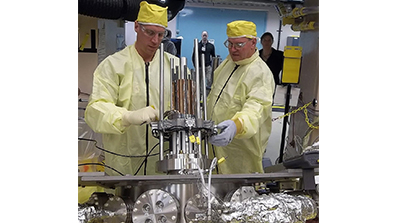The U.S. Department of Energy (DOE) National Nuclear Security Administration (NNSA)’s Nevada National Security Site (NNSS) is among the teams honored with the Gears of Government President’s Award for its Kilopower Reactor Using Stirling Technology (KRUSTY) experiment with NASA. The accolade celebrates the contributions of federal employees and teams who make profound differences in the lives of U.S. citizens.
The partnership between NASA’s Glenn Research Center, NASA’s Marshall Space Flight Center, DOE, NNSA, the NNSS, Los Alamos National Laboratory and Y-12 National Security Complex resulted in the successful demonstration of a new nuclear reactor power system that could enable long-duration crewed missions to the moon, Mars and destinations beyond.
In addition to delivering a one-of-a-kind, safe, secure facility to support the project, the NNSS also provided extensive personnel who are uniquely trained and qualified to perform high-security, one-of-a-kind experiments such as Kilopower.
Two years prior to the Kilopower experiments, NNSS employees began providing support for the project by readying the rooms to be used in the National Criticality Experiments Research Center – located within the Device Assembly Facility (DAF).

Every day there’s a cadre of people at NNSS facilities, such as the DAF, who enable scientists from National Labs and other governmental agencies to conduct high-level, high-security experiments like Kilopower. Total, more than 100 NNSS employees – design and systems engineers, technicians, project managers, administrative professionals, project control specialists, procurement specialists, and construction and safety basis personnel – were involved in supporting the Kilopower project.
The experiment was conducted from November 2017 to March 2018 at the NNSS; it included a full-power demonstration for 28 hours and showed that the system could operate under multiple system failures.
Kilopower is a small, lightweight fission power system capable of providing up to 10 kilowatts of electrical power – enough to run several average households – continuously for at least 10 years. Four Kilopower units would provide enough power to establish an outpost.
The prototype power system uses a solid, cast uranium-235 reactor core, about the size of a paper towel roll. Passive sodium heat pipes transfer reactor heat to high-efficiency Stirling engines, which convert the heat to electricity.
For more information about the award-winning KRUSTY team, visit https://www.performance.gov/gearawards/KRUSTY-Team/ or https://www.youtube.com/watch?v=KZQ2u2AVrkU.

